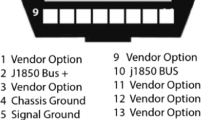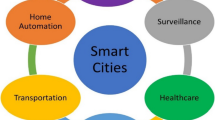Abstract
In recent times, bus arrival time prediction (BATP) systems are gaining more popularity in the field of advanced public transportation systems, a major functional area under intelligent transportation systems. BATP systems aim to predict bus arrival times at various bus stops and provide the same to passenger’s pre-trip or while waiting at bus stops. A BATP system, which is accurate, is expected to attract more commuters to public transport, thus helping to reduce congestion. However, such accurate prediction of bus arrival still remains a challenge, especially under heterogeneous and lane-less traffic conditions such as the one existing in India. The uncertainty associated with such traffic is very high and hence the usual approach of prediction based on average speed will not be enough for accurate prediction. To make accurate predictions under such conditions, there is a need to identify correct inputs and suitable prediction methodology that can capture the variations in travel time. To accomplish the above goal, a robust framework relying on data analytics is proposed in this study. The spatial and temporal patterns in travel times were identified in real time by performing cluster analysis and the significant inputs thus identified were used for the prediction. The prediction algorithm used the Adaptive Kalman Filter approach, to take into account of the high variability in travel time. The proposed schemes were corroborated using real-world GPS data and the results obtained are very promising.

(Source: Openstreet Maps)






Similar content being viewed by others
Notes
The running time of an algorithm, f(x) (where x is the input size) is said to be O(g(x)), which is read as f(x) is big-oh of g(x), if and only if there are constants C and n0 such that \(\left| {f(x)} \right| \leqslant {\mathbf{C}}\left| {g(x)} \right|\) whenever x > n0.
References
Afandizadeh SH, Khaksar H, Kalantari N (2013) Bus fleet optimization using genetic algorithm a case study of Mashhad. IJCE Trans A Civil Eng Int J Civil Eng 11(1):43–52
Schweiger C (2000) Real-time bus arrival information systems. Technical report, Transportation Research Board, TCRP Synthesis 48, Washington DC
Zhang L (2014) Pattern-based short-term traffic forecasting for urban heterogeneous conditions. IJCE Trans A Civil Eng Int J Civil Eng 12(3):371–377
Kwon J, Coifman B, Bickel P (2007) Day-to-day travel-time trends and travel-time prediction from loop-detector data. In Transportation research board: Journal of the Transportation Research Board, No. 1717, Transportation Research Board, National Research Council, Washington, D.C., pp. 120–129
Lee WC, Si W, Chen LJ, Chen MC (2012) HTTP: a new framework for bus travel time prediction based on historical trajectories. In: Proceedings of the 20th International Conference on Advances in Geographic Information Systems
Jensen CS, Tie D (2008) TransDB: GPS data management with applications in collective transport. In: Proceedings of the 5th Annual International Conference on Mobile and Ubiquitous Systems: Computing, Networking, and Services, Mobiquitous, ICST, Brussels
Elhanawy M, Chen H, Rakha HA (2014) Dynamic travel time prediction using genetic programming. In: Proc. of the Transportation Research Board 93rd Annual Meeting, Washington, DC
Min W, Wynter L (2011) Real-time road traffic prediction with spatio-temporal correlations. Transp Res Part C Emerg Technol 19:606–616
Patnaik J, Chein S, Bladihas A (2004) Estimation of bus arrival times using APC data. J Public Transp 7(1):1–20
Liu H, Zhang K, He R, Li J (2009) A neural network model for travel time prediction. In: IEEE International Conference on Intelligent Transportation Systems, Shanghai
Afandizadesh S, Kianffar J (2009) A hybrid neuro-genetic approach to short-term traffic volume prediction. IJCE Trans A Civil Eng Int J Civil Eng 7(1):41–48
Rezaie MF, Afandizadeh S, Ziyadi M (2011) Prediction of accident severity using artificial neural networks. Int J Civil Eng 9(1):41–48
Hinsbergen VCPJ, Van Lint JWC, Van Zuylen HJ (2009) Bayesian committee of neural networks to predict travel times with confidence intervals. Transp Res Part C Emerg Technol 17:498–509
Bansal P, Chen MC, Hsu CC (2015) A freeway travel time prediction and feature selection model integrating principal component analysis and neural networks. In Proc. of the transportation research board 94th annual meeting, Washington, DC
Fan W, Gummu ZK (2014) Dynamic travel time prediction models for buses using only GPS Data. In: Proc. of the transportation research board 93rd annual meeting, Washington, DC
Lin Y, Yang X, Zou N, Lei J (2013) Real-time bus arrival time prediction: an application to the case of Chinese cities. In: Proc. of the transportation research board 92nd annual meeting, Washington, DC
Vanajakshi L, Rilett L (2007) Support vector machine technique for the short term prediction of travel time. In: IEEE Intelligent Vehicles Symposium, Istanbul
Yu B, Lam WHK, Tam ML (2011) Bus arrival time prediction at bus stop with multiple routes. Transp Res Part C Emerg Technol 19:1157–1170
Guin A (2006) Travel time prediction using a seasonal autoregressive integrated moving average time series model. In: IEEE Intelligent Transportation Systems conference
Krishnan R, Polak J (2008) Short-term travel time prediction: an overview of methods and recurring themes. In: Proceedings of the Transportation Planning and Implementation Methodologies for Developing Countries Conference (TPMDC), Mumbai
Esawey Md, Sayed T (2011) Using buses as probes for neighbor links travel time estimation in an urban network. Transp Lett Int J Transp Res 3:279–292
Son B, Kim HJ, Shin CH, Lee SK (2004) Bus arrival time prediction method for ITS application. In Knowledge based intelligent information and engineering systems. Springer, Berlin Heidelberg, pp 88–94
Shalaby A, Farhan A (2004) Prediction models of bus arrival and departure times using AVL and APC data. J Public Trans 7(1):41–60
Chu L, Oh JS, Recker W (2005) Adaptive kalman filter based freeway travel time estimation. In Proceedings of transportation research board, transportation research board, National Research Council, Washington, DC
Vanajakshi L, Subramanian SC, Sivanandan R (2009) Travel time prediction under heterogeneous traffic conditions using GPS data from buses. IET J Intell Transp Syst 3(1):1–9
Padmanabhan RPS, Divakar K, Vanajakshi L, Subramanian SC (2009) Development of a real-time bus arrival prediction system for Indian traffic conditions. IET J Intell Transp Syst 4(3):189–200
Chamberlain RG (2014) Great circle distance between two points. http://www.movabletype.co.uk/scripts/gis-faq-5.1.html. Accessed 31 Mar 2014
Rees DG (2001) Essential statistics. Chapman & Hall/CRC Publishing, Inc., London
Yuan J, Zheng Y, Zhang C, Xie W, Xie X, Sun G, Huang Y (2010) T-drive: driving directions based on taxi trajectories. In: Proceedings of 18th SIGSPATIAL international conference on advances in geographic information systems
Kalman RE (1960) A new approach to linear filtering and prediction problems. Trans ASME J Basic Eng 82(1):35–45
Bhandari RR (2005) Bus Arrival Time Prediction using Stochastic Time Series and Markov Chains. In Ph. D dissertation, Department of Civil Engineering, New Jersey Institute of Technology. http://archives.njit.edu/vol01/etd/2000s/2005/njit-etd2005-038/njit-etd2005-038.pdf. Accessed 12 Jan 2013
Crout DT (2007) Accuracy and precision of TriMet’s transit tracker system. In: Proceedings of the 86th annual meeting, Transportation Research Board of the National Academics, Washington, DC
Warman P (2003) Measure impacts of real-time control and information systems for bus services. Transport Direct, UK Department of Transport
Verma A, Sreenivasulu S, Dash N (2011) Achieving sustainable transportation system for Indian cities—problems and issues. Curr Sci 100(9):1328–1339
Acknowledgements
The authors acknowledge the support for this study as a part of the sub-project CIE/10-11/168/IITM/LELI under the Centre of Excellence in Urban Transport project funded by the Ministry of Urban Development, Government of India, through letter No. N-11025/30/2008-UCD.
Author information
Authors and Affiliations
Corresponding author
Rights and permissions
About this article
Cite this article
Behera, R., Kumar, B.A. & Vanajakshi, L. Real Time Identification of Inputs for a BATP System Using Data Analytics. Int J Civ Eng 15, 1173–1185 (2017). https://doi.org/10.1007/s40999-017-0210-y
Received:
Revised:
Accepted:
Published:
Issue Date:
DOI: https://doi.org/10.1007/s40999-017-0210-y




